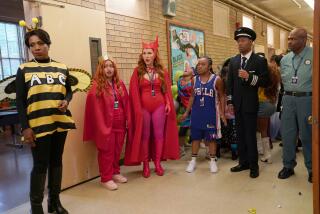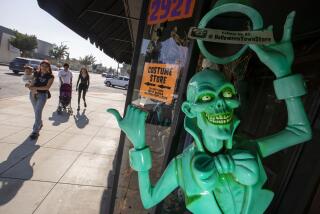Halloween Tricks Can Lead to Court
- Share via
Stories of pins in apples and other hazards are common to Halloween, but there is a lesser-known concern for parents on the annual fright night: getting sued.
Mischief--from the vandalism of breaking windows to causing a traffic accident by throwing eggs at cars--can result in a parent going to court.
“Unfortunately, children like to get into trouble on Halloween and that can come back to haunt (their parents),” said Vaughn de Kirby, a personal injury attorney in San Diego.
In California, parents are not usually liable for their children’s actions unless there is a specific law pertaining to that action, but there are four major exceptions and each is applicable to Halloween mischief.
Parents may be held liable if they know their child is likely to cause trouble but take no precautions; if the child deliberately does something he or she knows is wrong; if the child has access to firearms; and if the child causes damage and injury while driving the family vehicle.
Courts have ruled that a parent is not liable--unless negligence is involved--for their children’s “friendly play” that results in injury or damage. But when children purposefully do something wrong, their parents are liable for up to $10,000 for each person injured or for damaged property.
De Kirby mentioned a case in which a 5-year-old child pushed and injured his baby-sitter on Halloween. The parents never told the baby-sitter about the child’s behavior problems and thus were liable for the baby-sitter’s injuries, he said.
“It can be anything from throwing eggs and water balloons to typical Halloween mischief that turns into vandalism,” de Kirby said. “I’ve found that a lot of parents are simply not aware of their liability under the law, and the chances for something like this happening are greatly increased on Halloween.”
Halloween also is a prime night for teen-agers to go celebrating in cars, creating an especially dangerous situation with so many costumed children trick-or-treating, de Kirby added.
Under California law, parents are liable for their children’s negligence, wrongful acts or omissions when operating the family vehicle, even if the child does not get the parents’ permission to take the car. Damages are limited to $15,000 for injury or death of one person and $30,000 for more than one person. Property damages are limited to $5,000 per accident. No one is liable for punitive damages.
For the types of dangers more typically associated with Halloween, a few hospitals in the San Diego area continue to offer free X-rays of candy and other goodies on Halloween, but many hospitals have dropped the service, saying it is ineffective.
X-rays do not detect many foreign objects, poisons and other contaminants in fruit, candy and other edible treats, said Children’s Hospital spokesman Mark Morelli.
“It lulls parents into a false sense of security. A better precaution is good common sense,” including parental supervision of their children while trick-or-treating and inspection of all goodies, Morelli said.
While there have been no confirmed incidents of children being injured by tainted candy in San Diego in recent years, each Halloween a few children are struck by vehicles or suffer other injuries due to masks that hinder their vision or costumes that restrict movements, officials said.
“That’s very important--a mask that doesn’t block a child’s view,” Morelli said. “There are usually a couple of traffic accidents where the child is all excited and runs into the street and doesn’t see the car (because of the mask).”
An alternative to masks are cosmetics, which allow greater creativity than a mask and will not block a child’s vision, officials said.
Because Halloween safety concerns are emphasized in school, many children already know to use common sense when trick-or-treating, said Eileen Callahan, spokeswoman for the UC San Diego Medical Center. The San Diego Regional Poison Center, a unit of the medical center, sends staffers into schools to educate children on the dangers of Halloween.
Halloween safety tips include:
* Young children should trick-or-treat before dark and always be accompanied by an adult.
* Costumes should be light-colored, fitted to prevent tripping, have reflective tape if worn after nightfall and be flame resistant. (Remember this means the material can catch fire but will resist burning.)
* Children should carry a flashlight and stay in their neighborhoods, visit only the homes of people they know and avoid houses with no lights on.
* No unwrapped candy should be accepted and goodies should not be eaten until examined by an adult.
* Discard any candy not in its original wrapper or in a wrapper that might have been tampered with.
* Children should observe basic safety precautions and be especially cautious when crossing the street.
* Motorists should be on the alert for trick-or-treaters.
* Those expecting trick-or-treaters should remove objects from their yards that are a hazard to children, such as sprinklers and garden tools.
* Dogs should be kept in the house or otherwise restrained.
* Alternative treats include nuts, raisins, sugar-free candy, stickers, finger puppets and other inexpensive novelty items.
More to Read
Sign up for Essential California
The most important California stories and recommendations in your inbox every morning.
You may occasionally receive promotional content from the Los Angeles Times.













